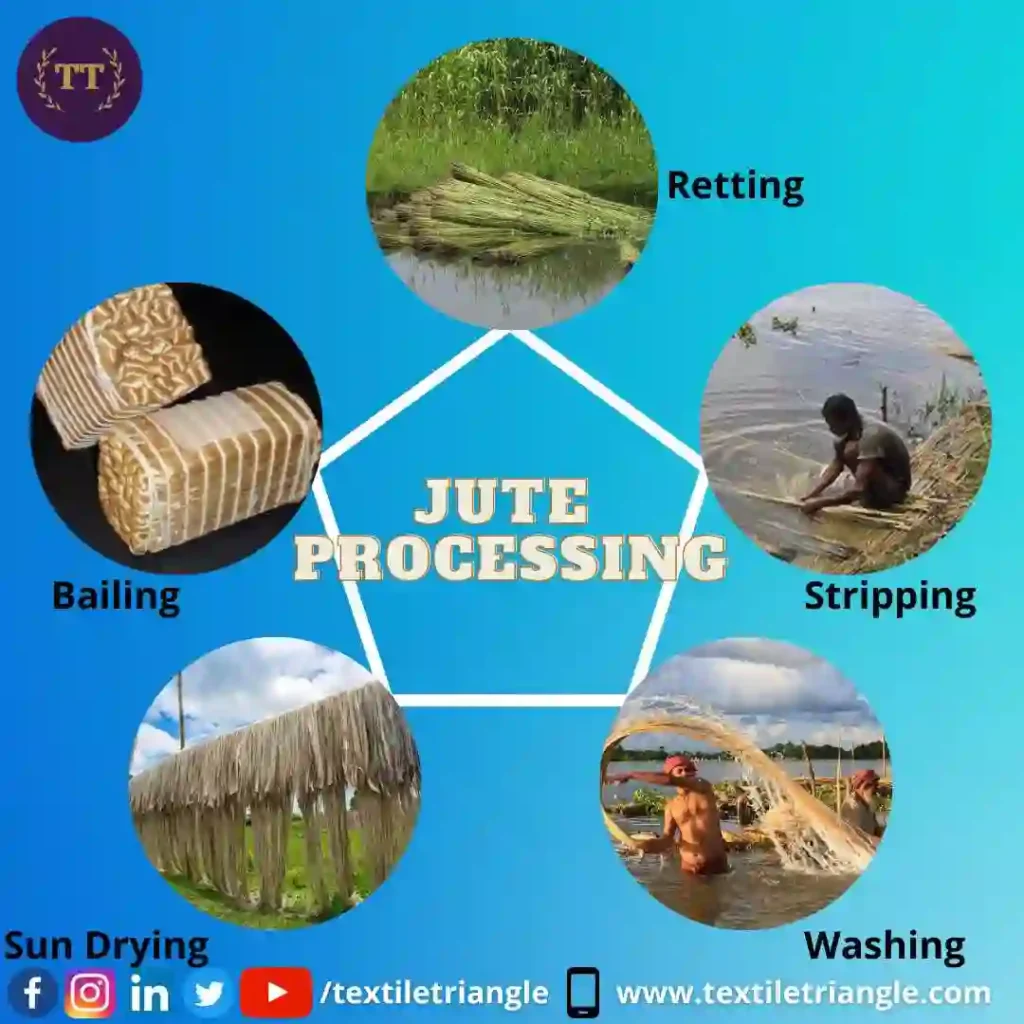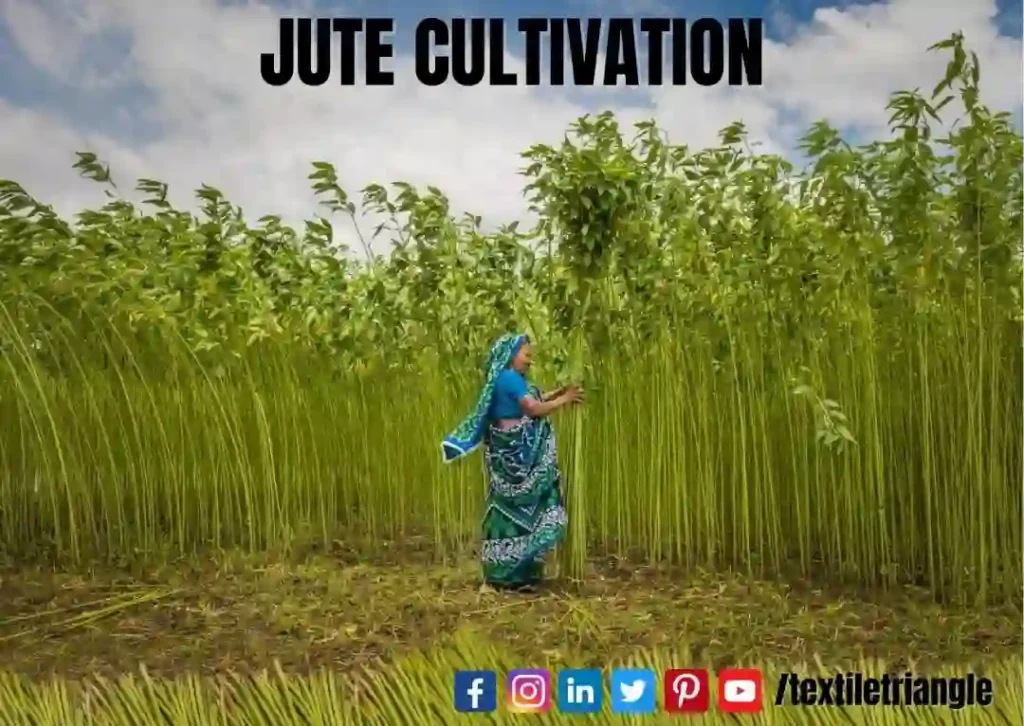Jute is primarily a monsoon crop. Jute Cultivation needs warm and humid climate, requires loamy or alluvial soil and standing water. Jute can be raised on all kinds of soils from clay to sandy loam, but loamy alluvial are best suited. Laterite and gravel soils are not suitable for this crop. The new grey alluvial soils of good depth, receiving silt from the annual floods are the best for jute cultivation. It thrives best where annual rainfall ranges from 150 to 250 cm, temperature from 20°C to 40°C and 70 to 90% relative humidity.
Jute is cultivated in which season
The crop is mainly cultivated in Ganga-Brahmaputra delta and their tributaries. Sowing is done from March to early June depending on species, rainfall and type of land. Seeds are sown by broadcast or dropped in furrows or line using drills. The seed are sown closely to produce unbranched jute plants. Unlike cotton, jute does not require much of fertilizers and pesticides. In early stages, weeding is needed.The plant matures in four to six months. It is harvested from June to September depending upon month of sowing (early or late). Early harvesting gives low yield, lack strength but white coloured fibre; whereas, late harvesting produces more yield but coarser fibres. For optimum yield and good quality fibres, it is advisable to harvest crop when half of the plants are at fruiting stage.
Processing of Jute | How is Jute cultivated
Bundlles of leafless stalks of jute, are transported from field to nearest water bodies for extraction of fibre. Stagnant water body such as pond or ditch are used for steeping the bundles. Sometime slow-running water is preferred for steeping the bundles for good Retting as stagnant water spoils the quality of fibres. To extract fibres from woody central part of the jute stem, the following steps are need to followed:
1. Retting 2. Stripping 3. Washing 4. Sun Drying 5. Bailing

Retting: Retting is a microbiological process which loosens the outer bark as well as separates the fibres from the woody central stalk during steeping. Bundles may be arranged in many layers on top of each other at right angles to the first in deep water. Bundles may be loaded with logs of wood or banana stem to ensure the bundle remain submerged/steeped in water to at least half to one meter depth.
The retting usually takes 10 to 30 days, depending upon maturity of the crop, the quality of retting water and its temperature. Depth of immersion and nature of water body (i.e. stagnant or flowing) also influence retting process and determines its completion. When the bark is easily peeled off from the stick or woody part, the retting is considered completed and the fibres are ready for stripping.
Stripping: After retting, next step is stripping or extracting the fibre. It is the process of removing the fibres from the central woody stick. Firstly, the root or ‘butt’ ends needs to be beaten with wooden mallet so as to loosen the fibre, then, fibres can be separated from the stick.
Washing: The stripped fibres are washed in clean water to remove the adhering periderm and pith. To remove the black colour, extracted fibers can be dipped in tamarind water for 15 minutes and again washed in clean water.
Sun Drying: After washing, the excess water can be squeezed off and then fibres are spread out on bamboo railing for sun drying for two to three days.
Bailing: The dried fibres depending on their quality or grades are rolled into bundles and pressed into bales. After bailing (kutcha bales), the packed raw jute is ready to transport to jute market or direct to jute mills.
Jute Cultivation in India | where is Jute cultivated in India | Jute Cultivation states in India
Jute is major fibre crop in India. Indian jute is exported to Nepal, USA, Ethopia, Japan. India also imports jute from Bangladesh. m families. There are around 94 composite jute mills out of which the state of West Bengal has 70 jute mills, Andhra Pradesh 10 mills, Uttar Pradesh 3 mills, Bihar 3 mills, Orissa 3 mills, Assam 2 mills, Chhattisgarh 2 mills and Tripura 1 Jute Mill. In India jute is primarily used in packaging industry as packaging material.
Jute Cultivation in West Bengal
West Bengal is major jute producing state in India. Climate and soil of West Bengal is suitable for jute cultivation. Ganga river water availability in West Bengal provide, sufficient water for jute processing. The jute mills of India also, concentrated in West Bengal region.
Frequently Asked Question about Jute Cultivation: FAQs
Where is jute mostly cultivated ?
Jute is mainly cultivated in eastern areas of India where hot and humid climate is available. Main jute growing areas are West Bengal, Assam, Northern Bihar, Orrisa, Tripura, Eastern Uttar Pradesh.
On which stage jute is cultivated ?
For optimum yield and good quality fibres, it is advisable to harvest crop when half of the plants are at fruiting stage. It take around 4-6 months to for jute plant to get matured.
In which soil jute will grow ?
Jute crop requires loamy or alluvial soil and standing water. Jute can be raised on all kinds of soils from clay to sandy loam, but loamy alluvial are best suited. Laterite and gravel soils are not suitable for this crop. The new grey alluvial soils of good depth, receiving silt from the annual floods are the best for jute cultivation.
How is jute crop harvested ?
To extract fibres from woody central part of the jute stem, the following steps are need to followed:
1. Retting 2. Stripping 3. Washing 4. Sun Drying 5. Bailing
How is jute made in India ?
Jute fibres are extracted from jute stem, by processing the jute crop. The process of jute fibre extraction jute stem includes following steps:
1. Retting 2. Stripping 3. Washing 4. Sun Drying 5. Bailing
How is jute cultivated India ?
Jute seeds are sown in alluvial soil near water areas. The Jute crop get matured in 4-6 months. Then jute is processed to get jute fibre from jute stem.
Is black soil suitable for jute cultivation ?
Black soil not preferable for jute cultivation. Loamy, new alluvial soil is best for jute cultivation.

